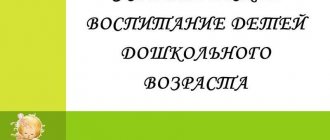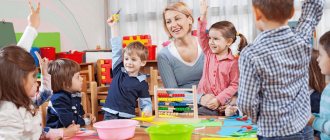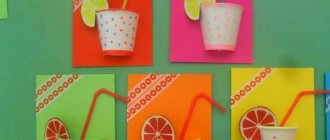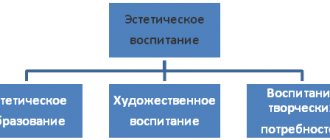Artistic and aesthetic development in the middle group
Being a priority area, artistic and aesthetic education occupies one of the leading places in the educational process. For the development of children’s personality in this area, various types of artistic activities are of great importance:
– visual activity
;
– musical activity
;
– artistic and speech activities, etc.
.
Nurturing children's creative abilities, developing aesthetic taste, needs and interests is one of the important tasks. Aesthetic development is the result of aesthetic education. One part of this process is arts education. This includes the development of abilities for artistic creativity, the acquisition of knowledge, skills and abilities in various types of arts.
Goals and objectives of artistic and aesthetic development in the middle group:
– Develop and raise children, taking into account the individual mental characteristics of each.
– To ensure the development of preschool children in the following types of activities: speech, cognitive, artistic and aesthetic.
– Form the basic foundation of personality.
– Create an environment and conditions for enrichment, diversity and further development of artistic activity.
– To carry out interaction between the family and the preschool institution in the artistic and aesthetic terms of children’s development.
In order to arouse children’s interest in decorative arts and painting, it is necessary to introduce them to such concepts as composition, color, coloring, form, which are means of expression in various types of art.
At drawing classes
children learn to create images. They are helped in this by their nature, which they are guided by or by their own ideas or associations. The subjects they try to depict are themes from life, natural phenomena, and the environment. The children get acquainted with shades of color, use them, and try to create images based on applied art.
Modeling and appliqué classes continue
. Preschoolers create both individual objects and compositions. At the same time, proportions are respected and the movements of the figures are conveyed.
During design
the guys “plan the stages of construction”, look for some constructive solutions, learn to interact with each other.
In music
children gain knowledge about musical instruments and genres of music. They learn to distinguish musical works by the introduction and by excerpts from the compositions. They master entry-level singing, learn to move rhythmically, change the smoothness and direction of movements. Gain skills to independently perform songs and dances.
Card index of games for artistic and aesthetic development in the middle group.
Progress of the game:
Objects are partially drawn in the pictures (bunny, Christmas tree.). You need to recognize the subject, fill in the parts that are missing, and color it.
“Let’s prepare the table for the holiday”
Target:
develop the ability to select shades of primary colors and create a beautiful color scheme.
Progress of the game:
In front of the children are cut out paper tablecloths of different colors (red, yellow, blue, green) and 4 - 5 shades of paper tableware of each color. The task is to match the main color to its shades. Select tableware so that the color matches the tablecloth.
Board game "Domino"
Target:
To consolidate children's knowledge about arts and crafts - toys; the ability to find the right toy and justify your choice. To consolidate knowledge about the manufacture of folk toys and the features of each. Cultivate a love of beauty.
“Paint a scarf for mom”
Target:
To consolidate children's knowledge about the art of the Russian shawl. To develop children's aesthetic taste, to teach them how to make simple patterns from various decorative elements (flowers, leaves, buds, twigs, etc.), and the ability to select the color scheme of a pattern.
"Art Crafts"
Target
: To consolidate children’s knowledge about folk arts and crafts; find the desired trade among others and justify your choice.
"Collect a Gzhel rose"
Target
: To consolidate children’s ability to compose a Gzhel rose using appliqué based on Gzhel painting, to maintain interest in Gzhel craft.
"Collect a matryoshka doll"
Target:
To consolidate children's knowledge about the folk toy - matryoshka; the ability to assemble a nesting doll from parts using the mosaic method. Highlight decoration elements. To cultivate respect and love for folk art.
“Complete the pattern”
Target:
The game is aimed at developing children's attention and memory, developing a sense of symmetry followed by coloring.
Progress of the game:
The beginning of the pattern is drawn on a piece of paper. Children need to extend the pattern further and color it.
“Find friends among the colors”
Target:
discover the level of children’s knowledge in choosing paint that matches the color of the object; draw in color
Progress of the game:
Silhouettes of objects are drawn on sheets of paper. The teacher gives the task to find “friends” of yellow, green, blue, and red colors among the objects. Children find objects that match a certain color and color them.
“Make a still life”
Target:
improve compositional skills, the ability to create a composition on a specific topic (still life), highlight the main thing, establish a connection by arranging the image in space.
Progress of the game:
The envelope contains images of various vegetables, fruits, as well as various vases, plates, dishes, and baskets. Children need to choose objects and create their own still life.
Abstract of OD on artistic and aesthetic development for children of the middle group. Snowflake
Summary of educational activities on artistic and aesthetic development in the middle group “Fairytale Snowflake”
Purpose: introducing children to an unconventional technique of drawing, using a wet sheet. Tasks. Educational: 1. improve the skills of non-traditional depiction of an object (with cotton swabs) (educational field “Artistic and Aesthetic Development”); 2. encourage attempts to share impressions with the teacher and other children (educational area “Speech development”, “Social and communicative development”). Developmental: 1.develop the ability to convey specific images of objects in a drawing (educational field “Artistic and Aesthetic Development”); 2. develop independence and creativity (educational field “Artistic and Aesthetic Development”); 3. continue to develop an interest in fiction (educational area “Reading fiction”). Educational: to cultivate friendly relationships between children (educational area “Social and communicative development”). Preliminary work: observations of seasonal changes in nature in winter, conversations about the characteristic signs of winter, reading poems about winter, looking at illustrations about winter. Materials: tinted sheets of paper for each child, white gouache, cotton swabs, wet wipes for hands, sponges, glasses of water, plates, audio recording: “The Seasons” by P.I. Tchaikovsky. Progress of educational activities. The teacher is part of the group with the children: Hello, my dears: Both small and large!
I see how you have grown, how good you are! I am glad to see you so beautiful, kind, and in a good mood!
We will spend this day together. May it bring you joy and many new interesting experiences. Let's make each other happy! Children, do you like fairy tales? Children. Yes! Educator. Would you like me to tell you a fairy tale? But you have to guess what this fairy tale is about. Stars are falling from the sky and will fall on the fields. Let the Black Earth hide under them. Many, many stars, thin as glass; The stars are cold, but the earth is warm.
(Snowflakes) Yes, this is a fairy tale about a snowflake, and it was written by a girl, Sofia Linovitskaya, from the city of Kaliningrad. Children sit on chairs in front of a laptop. As the teacher tells the story, the illustrations change on the screen and calm music plays. “Once upon a time there was a little white snowflake beauty. She was born in the sky and her mother was a large, clumsy snow cloud, and there were no number of snowflake sisters.
Snowflake could sit on the edge of a cloud for hours and look at the ground with curiosity, but she didn’t want to fall at all, because she had never flown and didn’t know how to do it, and everything unknown scares. In addition, she did not want to part with her mother like a cloud, because for her the harsh cold snow cloud was the most affectionate and dear.
But one day a gust of angry northern wind picked up a light snowflake, it could not resist and flew down. And now she is already on earth. She was lucky enough to land in the cozy courtyard of a multi-story building. She calmed down, feeling at home in this hospitable courtyard, and fell asleep sweetly.
In the morning she was awakened by loud screams and ringing laughter. She opened her eyes, and there was such joy and fun all around! The children from the house near which the snowflake fell were happy about the first snow that had fallen overnight and ran out into the street. In the yard they played snowballs, sledded, made a snow woman and simply fell into the snowdrifts with a running start. Snowflake gladly took part in all the children's fun.
A snowflake lived all winter in a hospitable courtyard. She finally found out why snowflakes fall from the sky: to give a good mood and joy to children and adults, to decorate the streets of cities, dressing them in snow-white clothes, and even to warm the earth! Yes Yes! Under the cold snow, as if under a warm blanket, grass, insects and even some animals dozed in anticipation of spring. In the spring, with the first warm rays of the sun, the snowflake turned into a transparent water droplet and flew away into the sky, only to return to earth again in winter as a sparkling snow-white snowflake.”
Did you like the fairy tale?
Children. Yes! Educator. Do you want to turn into snowflakes? Children . Yes! Educator. Then put your hands on your belt and say the magic words: “Turn right, turn left and turn into a snowflake!” Imitation exercise “Snowflakes” (emancipation, emotional release). Oh, snowflakes are flying and flying, (Children are running in all directions) Snow-white fluffs, This winter-winter has taken up its sleeves. (Smooth hand movements left and right) All the snowflakes began to spin (Spin in place) And lowered them to the ground. (Squat). Educator. Now let's turn into children again. Who you are? Children. Children. Educator. Many adults and even children forget after some time what they saw or did. For example, forget this fairy tale. What can you do to not forget this one? Children. (Children's answers.) Educator. You can also draw a picture. When you look at him, you will remember this fairy tale. Do you agree? Children. Yes. Educator. To make the drawing unusual, I suggest drawing it using an unconventional technique, on a wet sheet. Now I will tell you and show you how to do it. Take a sponge and wet a sheet of paper.
Then, using a cotton swab, draw a line across the wet sheet from top to bottom to make a straight line.
Then draw from the upper left corner to the middle, and from the middle down.
Also from the upper right corner to the middle and down.
If you have time, draw short rays on the main rays. You need to draw with short strokes from top to bottom.
The children take their seats. Educator. Before we start work, let’s say what color we will paint the snowflakes, and prepare our fingers for work, warm them up. Children perform finger gymnastics.
A sponge means foam rubber, clenching the sponge into a fist, and he is capricious. It can quickly absorb alternating transmission from hand to hand in rhythm And it gets darker and heavier. verse. But we get the desired drawing - very light and airy. Independent work of children. When the children are finished, they place their work on the easel.
Reflection. Educator. What did you do today? (drew snowflakes). How did you draw snowflakes? (on a wet sheet). What did you use instead of a brush? (cotton buds). What can you say about snowflakes? (beautiful, airy, light...). Why did they draw snowflakes? (so as not to forget the fairy tale). Thank you guys for keeping me company. What's your mood? - Wow! (show thumb). Let's give our good mood to others. (Children blow the mood off their palms).
We recommend watching:
Synopsis of preschool education on speech artistic and aesthetic development in the middle group of kindergarten Synopsis of educational activities on the development of coherent speech for children of the middle group “Winter”. Summary of educational activities in the middle group of a kindergarten using ICT Summary of educational activities in the middle group of a kindergarten: Let's help the birds
Similar articles:
Lesson in the middle group “Winter clothes”
Observation of the work of a janitor in winter in the middle group
Lesson on the topic: New Year in kindergarten for children of senior preschool age







